
 by Steven D. Johnson
by Steven D. Johnson
Racine, Wisconsin
(Page 4 of 4)
Previous Page
1
2
3
4
Pallet Manufacturing
Click on any picture to see a larger version.
Inside the massive shop, they refer to them as "repaired" pallets, but that term hardly does the system justice. In reality, the used pallets sold by World Wide Box & Packaging Corp. are "remanufactured." Relatively intact pallets, called "cores," are tested, tightened, and new parts added as necessary to return them to "almost new" condition.
Pallets that are "beyond repair" are disassembled and the individual parts are reused as is, cut to a smaller size and used in new pallet construction, or scrapped for eventual reuse as animal bedding, mulch, or any of a dozen other uses. Nothing is wasted. Nails and other bits of scrap metal are sorted and gathered and will make their way to a scrap metal recycler.
The bywords in this shop are efficiency, safety, service, and quality. "In a commodity business like pallets, customer service is what really counts." Of course Trevor Miller, co-owner, admits that not all customers are willing to pay for high quality service. But customers who do care about quality, service, and reliability tend to also be long term repeat customers; so without the cost of customer acquisition and on-boarding, more investment can be made in supplying top notch quality and service.
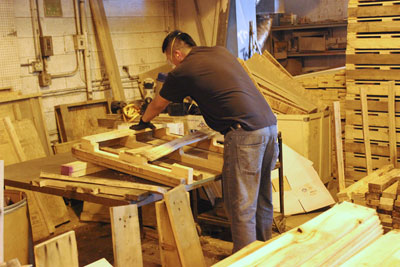
|
Figure 7 - Many used pallets are tested, selectively
deconstructed, and rebuilt by hand. Note the gloves,
dust mask, hearing and eye protection!
|
A standard used, but remanufactured, GMA pallet sells for somewhere in the $4 to $5 range in this market, and the remanufacturing cost averages about $1.50 per pallet. Of course the used pallets have to be purchased, and Trevor pays from $2 to $2.25 for used pallets. That leaves $1 or less profit on each pallet, if everything is running perfectly. The quality of pallet "cores" – the used pallets arriving daily at World Wide Box & Packaging – has gone down over the past few years. "Companies are using pallets longer before disposing, selling, or otherwise retiring them. As a consequence, the remanufacturing cost has doubled in the past few years," according to Trevor.
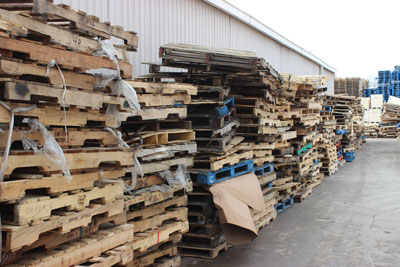
|
Figure 8 - Initial staging area for incoming
used pallets (cores)
|
New GMA pallets sell for $10 to $12 apiece, but, as Trevor says, "There are a lot of companies out there that specialize in new pallet production with highly automated machines that can crank out over a 1,000 pallets in each 8-hour shift." These high volume, low margin, commodity pallet makers use capital-intensive machinery and run with minimal labor. A thousand-pallet-a-day production line may only have two employees.
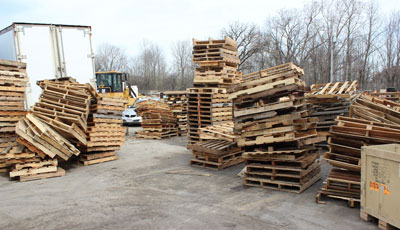
|
Figure 9 - Pallet receiving "overflow" area. Most will
be sorted, repaired or rebuilt, and gone tomorrow.
|
While many new standard commodity-size pallet manufacturers also operate a used pallet business, World Wide Box & Packaging has found a comfortable niche making high-end custom pallets and boxes, keeping costs low by leaning on the used pallet business only to help to defray operational overhead and provide lower cost raw materials. In the niche World Wide has chosen to serve, there is more profit potential in custom products. The company receives CAD drawings and blueprints, works out the production cost, and submits a bid. Low bidder often gets the order, but for many long-term World Wide customers, the bid process is a formality. "Perhaps the bid is just to keep us honest," says Trevor, "but they want to do business with us because they have confidence in the quality of the end product and our ability to deliver on time."
Some of the pallets and boxes made at World Wide really fall into the category of "shipping system." I wondered what a pin router would be used for in a pallet-making shop, and the team showed me a wooden system consisting of a base pallet with tapered rounded bracing and specially cut out, notched, and shaped wooden assemblies that hold very precise components. There is a bolt-on wood lid that protects each component. The engineering and craftsmanship behind each of these "boxes" would impress even the most talented woodworker, and they are turning out these special shipping systems by the dozens every day.
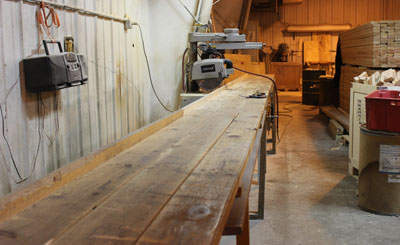
|
Figure 10 - This does beg the question,
"Exactly how long are the boards you crosscut???
|
The blueprints and CAD drawings for some custom shipping containers run a half-dozen pages or more. I've seen less (and less sophisticated) drawings for making a Queen Anne dresser.
Any pallet, box, or shipping system that is intended for export use must meet stringent International Standard for Phytosanitary Measures (ISPM) Regulation 15 which is designed to help prevent the worldwide spread of plant pests and disease by using specially treated wooden packaging materials. Heat treating is the preferred method, wherein finished pallets and boxes are literally "cooked" at a high temperature. A wood shipping container or pallet so treated can then carry the IPPC (International Plant Protection Convention) mark and can be used for export.
World Wide Box & Packaging meets those stringent standards, but they wonder about the effectiveness and fairness of the system. Trevor showed me a stack of pallets and wooden boxes that came from China, carrying products that passed through our ports, but the crates and boxes were later deemed unsafe for reuse. Safe enough to use to ship products to us, but not safe enough for us to use for export seems, on the surface, a double standard --- at least to this reporter. Those Chinese-made pallets and boxes have to be destroyed. Unfortunate, since the company strives to recycle everything.
Some pallet manufacturers do heat treating on-site, but many, like World Wide, choose to outsource the heat treatment process (and the regulatory paperwork) to another company. Full truckloads of pallets can be treated at one time. The cost varies, but average cost for heat-treating a typical GMA pallet runs about $1 each.
It struck me as counterintuitive that while standards are set for the treatment of wood products used for international shipment, there is no control over what happens to pallets after they are heat treated. Heat treated pallets could be delivered to a shipper, then sit outside for weeks or even months before being used. No telling how many bugs could take up residence during that time.
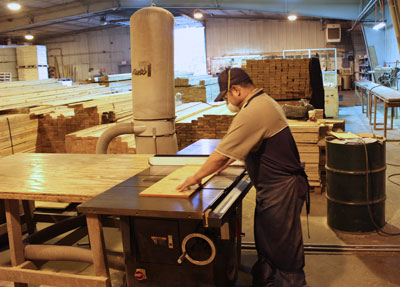
|
Figure 11 - The SawStop runs 8 hours/day, 5 days
a week. World Wide has never had an "event" and
only one misfire, that caused by some excessively
wet pressure treated wood.
|
Plywood, particle board, OSB, and MDF made in the US meets ISPM15 standards for export because of the high heat, pressure, and glues used during manufacturing… no bug could live long in there… but the plywood that comes from China is not generally deemed safe as the glues are insufficient and there is not enough heat applied during manufacture to kill the bugs.
While touring the facility I asked Trevor about the ubiquitous blue Chep pallet, and the reaction was not very positive. You have probably heard the term "Chep" pallet. Chep (and other companies like them) manufacture and supply what are essentially "rental" pallets. Even if you have not heard the name "Chep" you have seen them... they are painted in a bold blue color… easily recognizable. The problem is, Chep claims ownership of all of their blue pallets, no matter how you came by them, and has a team of attorneys to enforce that. If a company receives product on a blue Chep pallet, then decides to discard the pallet, that pallet may change hands many, many times, but Chep retains and maintains their ownership. Therefore, if a truckload of used pallets comes in, any blue "Chep" pallets have to be removed from the shipment and stacked separately. Periodically the company will contact Chep (or a Chep representative) and make arrangements for the pallets to be picked up… even though the pallets may have been purchased as part of a bulk load of used pallets.
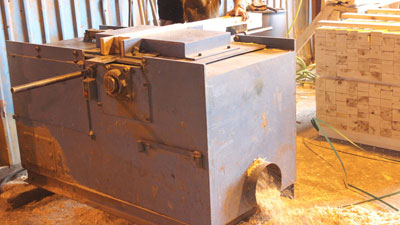
|
Figure 12 - This machine cuts notches in pallet
stringers, four at a time
|
Some of the equipment in World Wide's several shop buildings would be recognizable to any woodworker. A large radial arm saw sits between two of the longest work support tables I have ever seen. A panel saw that looks, from a distance, much like the panel saw in your local big box lumber store, is actually much larger with a far beefier motor and heavier guides and rails. Sitting in the middle of the main shop is a SawStop Industrial Cabinet Saw that all the employees call the "hot dog saw." Obviously they have all seen the demonstration. Air-powered nailers abound… they are everywhere you look.
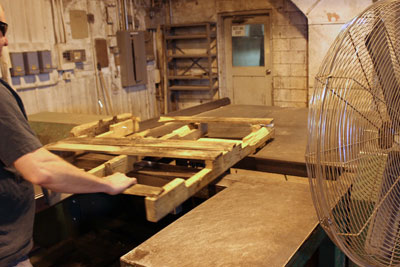
|
Figure 13 - A deceptively simple but effective way
to disassemble pallets. A wide band saw blade cuts
flush with the stringers as the pallet is pulled across
the work surface. The deck boards drop through
a slot onto a conveyor below.
|
There is some specialized equipment, too. A "notcher" cuts pallet stringer notches, 4 stringers at a time. The machine that disassembles used (and not worth repairing) pallets is essentially a big horizontal air-powered band saw. The blade rips through nails and separates pallet parts at a very high rate of speed. The blades cost $60 apiece and last about 2-1/2 to 3 days in this demanding environment. As the pallet pieces are separated, a conveyor grabs usable boards, turns and aligns them, and cuts them to an operator-set length for use in making new pallets. Broken bits of wood and metal pieces are separated and flow into bins for recycling. As stated before, absolutely nothing is wasted.
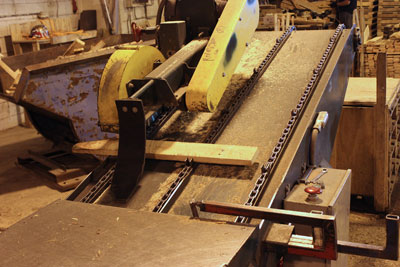
|
Figure 14 - The conveyor turns the board, butts
one end to an adjustable length stop, and then
carries the board through the saw to be cut to
length for a new pallet.
|
By all appearances, the company appears to be thriving. Trevor is a hands-on and involved owner/manager, and his insistence on quality, efficiency, and worker safety shows in every aspect of the company's operations. When asked what is next for World Wide Box & Packaging, he spoke mainly of capital investments that will improve operations and employee comfort.
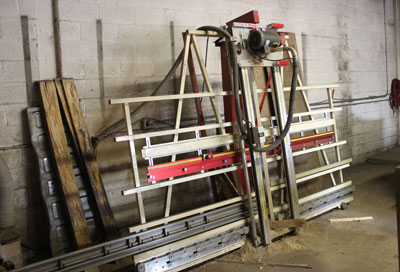
|
Figure 15 - Some custom pallets and boxes require
sheet goods, and this large panel saw makes quick
work of cutting pieces to size.
|
For example, the company will soon be installing a new dock system that will allow workers to more easily load and unload trucks. And while that big radial arm saw crosscutting station will stay, World Wide is considering a machine that will cut an entire bunk of lumber to length at one time. The company may also venture into grinding. That would allow them to grind their own scrap wood on site, lowering transportation and handling costs.
For a down-to-earth woodworker, seeing an operation like this is humbling… and enlightening. The next time I am tempted to dismantle a pallet and make a project from the wood, I will wonder where the pallet was made, how many journeys it has been on, what foreign countries it has seen, and if in all its travels it one day passed through World Wide Box & Packaging Corp.
---------------------------------------
Next month in the Down To Earth Woodworker, I have finally solved a lingering mystery surrounding some disappearing shop tools and supplies. We will also take a look at how technology is changing woodworking and what we can expect to see in the near future. There are some new products I want, too… someone needs to make them available. There are business opportunities in the offing! See you next month!
(Page 4 of 4)
Previous Page
1
2
3
4
Steven Johnson is retired from an almost 30-year career selling medical equipment and
supplies, and now enjoys improving his shop, his skills, and his designs on a full time basis
(although he says home improvement projects and furniture building have been hobbies for most of his
adult life).
Steven can be reached directly via email at downtoearthwoodworks@me.com.
Return to Wood News front page
